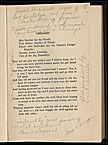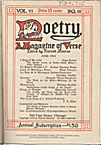| Entries |
| C |
|
Chicago Literary Renaissance
|

|
But the term “Chicago Renaissance,” as it is usually used, applies more precisely to the second wave of Chicago writing. It describes a gathering of writers, a flowering of institutions that supported and guided them, and the outpouring of writing they produced between about 1910 and the mid-1920s. Major figures include novelists Dreiser (whose career extended well into this period), Sherwood Anderson, and Floyd Dell; poets Carl Sandburg, Harriet Monroe, Edgar Lee Masters, and Vachel Lindsay; reporters Ben Hecht and Ring Lardner; and editors and critics Monroe, Dell, Margaret Anderson, and Henry Justin Smith. In this period, Chicago's newspapers often served as incubators for literary careers. Little magazines like Monroe's Poetry, Margaret Anderson's Little Review, Dell's Friday Literary Review, the Dial, and the Chap-Book, orchestrated an encounter between American and European innovators. These magazines introduced not only Chicago writers but also Pound, Yeats, Joyce, and Lawrence to the American literary scene. While Jane Addams and Hull House provided a guiding force for social reformers, the Hull House Theater joined the Little Theatre and Players' Workshop in offering venues for experimental drama. The University of Chicago nurtured both literary and social scientific exploration of urban life. Writers' groups, especially the Little Room group and the reporters' roundtable at Schlogl's restaurant, encouraged networks of influence and inspiration. Looser alliances of female artists and editors—among them Monroe, Addams, Margaret Anderson, Edith Wyatt, Susan Glaspell, Clara Laughlin, and Margery Currey—struggled to extend and break through the conventional limits on women's participation in artistic, civic, and domestic life.

|
The Chicago Renaissance “brought the world to Chicago and Chicago to the world,” as literary critic Carla Cappetti puts it. If American and international observers had already accepted Chicago's furious growth, industrial productivity, and bruising social dynamics as important social facts, it was only in the 1910s that prominent intellectuals began to respond to the writing that Chicago produced as culturally significant. H. L. Mencken led the way, identifying Chicago and its hinterland as “the Literary Capital of the United States.” Mencken argued that “Chicago habits of mind” produced an original, genuinely national literature that made art from the principal stories and idioms of American life: the westering of the wellsprings of American culture, the rise of the metropolis and the concomitant crisis in the small towns from which so many Chicago writers of the period came, the clash and combination of a democratic culture's heterogeneous voices. Subsequent generations of critics would continue to seek the significance of Chicago writing in its emphasis on working people and the hard facts of city life.
European and expatriate high modernism eclipsed Chicago realism by the late 1920s, when an exodus of novelists, poets, editors, critics, and reporters from Chicago to points east marked the waning of Chicago literature's second wave. Still to come, though, was the third wave in the 1930s and 1940s. That being the case, we might more profitably regard the period between the Great Fire and the mid-twentieth century as a single renaissance in which Chicago's writers, engaging with landscape and humanity in compelling motion around them, did much to give form and meaning to our imaginative encounter with modern urbanism.
The Encyclopedia of Chicago © 2004 The Newberry Library. All Rights Reserved. Portions are copyrighted by other institutions and individuals. Additional information on copyright and permissions.